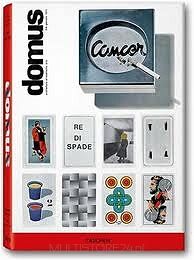


 ostatnia szt
ostatnia szt
 Kup teraz, zapłać za 30 dni.
Kup teraz, zapłać za 30 dni.
 Szybkie płatności Blik.
Szybkie płatności Blik.
Rok wydania: 2009-01-25
Ilość stron: 580
Oprawa: twarda
Format: 318 x 229 mm
This title provides the quintessential works of Modernism. For eight decades, "Domus" has been hailed as the world's most influential architecture and design journal. Founded in 1928 by the great Milanese architect Gio Ponti, the magazine's central agenda has always remained that of creating a privileged insight toward identifying the style of a particular age, from Art Deco, Modern Movement, Functionalism and Postwar to Pop, Postmodernism and Late Modern. Beautifully designed and comprehensively documented, page after page "Domus" presents some of the most exciting design and architecture projects from around the world. Each of the 12 volumes in TASCHEN's "Domus" reprint collection reproduces a selection of the magazine's pages as they originally appeared, and is packed with articles that bring to light the incredible history of modern design and architecture. Available as separate volumes covering the period of 1928-1999, this series is a major publishing achievement and an important must-have for all design and architecture teaching institutions, practicing architects, designers, collectors, students, and anyone who loves design. It also covers the period of 1970-1974: individuality reigns supreme. This volume covers the early 1970s, a time when an extreme change was taking place in the fields of architecture and design. Since the late 1960s, the emergence of pop culture, new forms of social coexistence, and the extreme positions of Anti and Radical Design had been provoking completely new ways of thinking. In architecture, a trend towards individuality was visible, which manifested itself through very different forms of style and construction. Functional, geometrical, and organic forms took shape equally alongside one another and were often interrelated. Futuristic architectural designs such as those by Luigi Moretti stood in contrast to the practical designs by Renzo Piano or Richard Rogers. At the same time, the first postmodern tendencies could be recognized. Japanese architects like Kisho Kuramata created completely new paths with their metabolic buildings and city planning, while in the field of design, the living landscapes by Verner Panton and Joe Colombo represented a remarkable new approach.